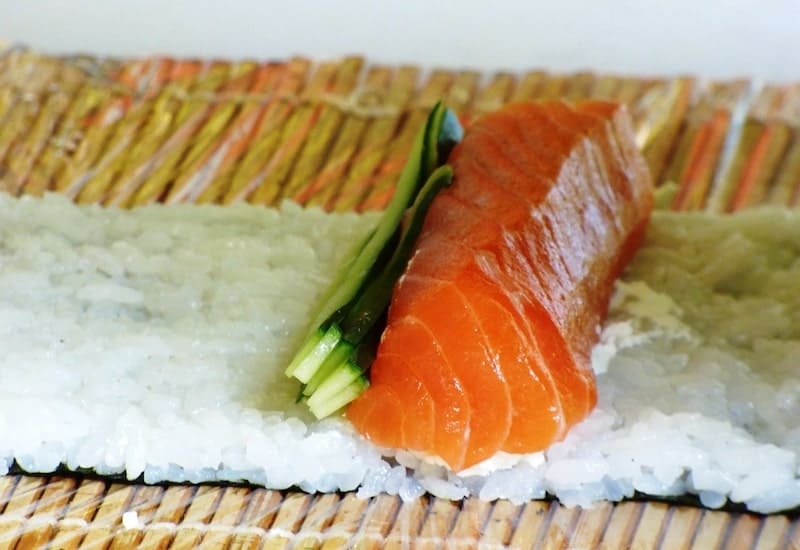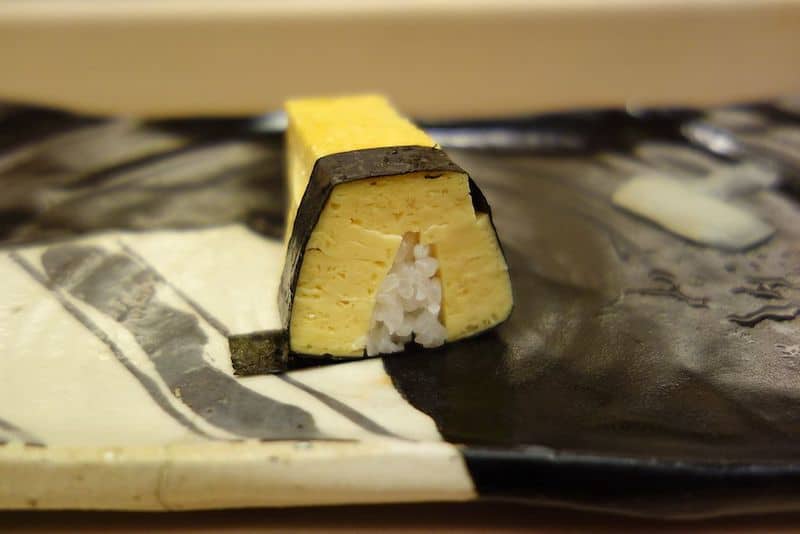What Do You Wrap Sushi In?
Sushi is an exceptionally visual dish. The colors of the fillings interweave neatly on the inside, and the edible ingredient used to hold it all together enhances the art of sushi.
So what is that edible ingredient that holds sushi together? What do you wrap sushi in?
When choosing a wrapping to create a sushi roll, the Japanese consider nutrition, how well it will work with the rest of the flavors, and the aesthetic. The ingredient traditionally used to wrap sushi is toasted Nori seaweed.
Since seaweed is an acquired taste, luckily, when making our own, you aren’t limited to using it, as there are plenty of options that work just as well.
If you don’t like seaweed or just wanted to know what else you could wrap your sushi in, you can find out in this article.
What Is Sushi Traditionally Wrapped In?
‘Maki,’ the original sushi roll of fish or vegetables, is customarily wrapped in an edible seaweed called Nori.
It’s a dark green, almost black-looking seaweed with a strong, distinct flavor. It derives from red algae and is farmed in the ocean. It just so happens that Japan is the greatest producer of it.
‘Maki’ sushi rolls, a combination of rice, fish, and Nori seaweed is a typical Japanese low calorific and nutritious dish. The fish offers a great source of omega-3 fatty acids, while the Nori adds to its nutritional benefit with high protein, minerals, vitamins, and fiber.
On average, a single piece of Maki roll contains roughly 48 calories.
The Japanese incorporate Nori into their seafood and soup dishes for its salty flavor. It can be eaten on its own or used as a garnish.
There are also other types of sushi that don’t have seaweed in them – click here to learn more.
What Else Can Sushi Be Wrapped In?
As long as the critical ingredient of vinegar-flavored rice is used to make sushi, it can be wrapped using a variety of other ingredients such as Tamagoyaki (Japanese omelet), thousands of tiny shrimp eggs, avocado, thin cucumber sheets, rice paper, tofu skin, soybean sheets, etc.,
There are many sushi dishes under five primary types: Nigiri, Sashimi, Maki, Uramaki, and Temaki. Some wrap the sushi using a layer of wrapping ingredients, while others use the sushi as the wrapping.
Tamagoyaki
A popular form of sushi is the Tamago sushi. This is sushi rice wrapped or topped with Tamagoyaki, which is a Japanese rolled omelet.
The Tamagoyaki is typically a combination of seasonings like rice vinegar, soy sauce, dashi stock, sugar, salt, Miri, and sake. It’s traditionally made in a rectangular Tamago pan to give it its shape; however, a regular pan can be used.
Avocado
You can use ultra-thin slices of avocado to hold and stick the fillings together. For this method to work, the avocado needs to be just right – not too hard or soft.
Place the slides overlapping each other on some plastic wrapping. When the slides are strategically laid like this, the avocado displays an attractive woven pattern on the outside. This method also provides structure and support to the wrap.
Next, the sushi filling is placed in the middle of the avocado slices, then wrapped around the fillings using a bamboo mat.
Rice Paper
Rice paper is created in East Asia using paper-like materials from various plants. The sheets are super thin and delicate so handling with care is a must to prevent it tearing during the wrapping process.
They are sold as dry and hard, so they need to be soaked in water for a few seconds to soften before wrapping.
Inari (Tofu)
Inari Sushi is sushi rice stuffed into deep-fried and seasoned tofu pockets called ‘Inari Age.’
Inari goes by other names like yuba, bean curd skin, or bean curd robes. It’s made from soybeans; though it’s not precisely proper tofu, it’s called tofu because of the similar flavor and texture.
Once deep-fried, it’s placed in boiling water to drain the excess oil, then simmered in a dashi-based broth or sweet and savory ingredients to absorb all the flavors.
Finally, the excess liquid is squeezed out before stuffing with the sushi.
Soy Bean Sheets
Soybean sheets or soy paper are primarily made from crushed soybeans, known as ‘mamenori’ in Japanese. They’re flexible, thin, and in Japan, they’re often used instead of Nori sheets to create a fusion named kawaii sushi rolls.
Soybean sheets are calorie-free, rich in protein, and are frequently available in various color options. There is no artificial coloring used to achieve the colors. Instead, natural food and plant extracts are used to give it that beautiful hue.
Inside-Out Sushi
The “inside-out” sushi is a type of uramaki roll, where the rice on the outside and Nori on the inside.
Using the California roll as an example, a typical recipe would start with the toasted Nori sheet followed by a layer of rice and a sprinkle of sesame seeds on top. Then place the rice side facing downwards on your plastic-wrapped bamboo mat.
Once the crab, cucumber, and avocado slices are laid on top, you can begin to roll, slice into bite-size pieces, then enjoy!
In Summary
The Japanese take the end-to-end sushi-making process seriously. Once the rice and fish or seafood preparation is on point, the wrapping ingredient must be perfect as well.
When deciding on a wrapping ingredient, they consider how healthy it is, how well it will complement the other flavors, and how aesthetically pleasing the result will be.
The Japanese traditionally use locally sourced Nori seaweed. Japanese rolled omelet Tamagoyaki is another popular option.
Sometimes colorful soy paper is used to enhance the combined colors of the ingredients. It gets its color from natural food and plant extracts.
Essentially, sushi can be encased in a layer of almost any ingredient!










